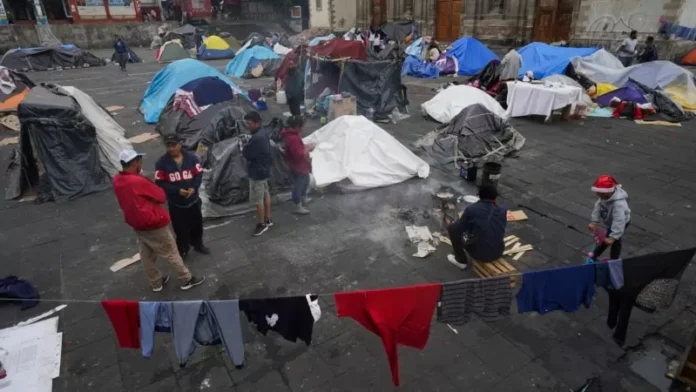Mexico City – “That’s it, dude! Done!” exclaimed Eliezer López as he jumped up and down, throwing his arms to the sky and drawing a sign of the cross across his chest. His joy was so contagious that his friends started to emerge from nearby tents to celebrate with him.
López, a 20-year-old Venezuelan migrant in Mexico City, had finally received the news he had been waiting for – an appointment to seek asylum in the United States through the U.S. Customs and Border Protection’s mobile app known as CBP One.
He is one of the thousands of migrants whose U.S.-bound journey has led them to the Mexican capital, the last point until recently from which migrants can register to request an appointment to seek asylum through CBP One.
Since June, when the Biden administration announced significant restrictions on migrants seeking asylum, the app became one of the only ways to request asylum at the Southwest border.
This U.S. asylum policy and its geographic limits have driven the emergence of migrant encampments throughout Mexico City, where thousands of migrants wait for weeks – even months – in limbo, living in crowded, makeshift camps with poor sanitation and grim living conditions.
From a transit point to a temporary destination
Historically, Mexico City has not been a stop for northbound migrants. They try to cross the country quickly to reach the northern border. But the delays in securing an appointment, coupled with the danger that plagues cartel-controlled northern Mexican border cities and the increased crackdown by Mexican authorities on migrants, have turned Mexico City from a point of transit to a temporary destination for thousands.
Some migrant camps have been dismantled by immigration authorities or abandoned over time. However, others, like the one where López has lived for the past few months, remain.
Like López, many migrants have opted to wait for their appointment in the relatively safer capital. However, Mexico City presents its own challenges.
Shelter capacity is limited, and unlike large U.S. cities like Chicago and New York, which rushed last winter to find housing for arriving migrants, in Mexico City, they are mainly left to their own devices.
Andrew Bahena, coordinator of the Coalition for Humane Immigrant Rights of Los Angeles, or CHIRLA, said that until late 2023, many migrants were contained in southern Mexican cities like Tapachula, near the border with Guatemala. Many tried to disguise their location to defeat CBP One’s geographic limits, but when U.S. authorities took notice, more migrants began aiming for Mexico City to make their appointments from there.
As a result, there has been an increase in the migrant population living in the camps.
“We talk about this as border externalization, and it’s something the United States and Mexico have been jointly implementing for years,” said Bahena. “The CBP One app is probably one of the best examples of that today.
“These folks are asylum seekers, not homeless people living in Mexico,” he added.
A maze of tents and tarps
When López first arrived in Mexico City at the end of April, he thought about renting a room. However, he soon realized it was not an option.
He earned $23 a day working three times a week at a market. Rent was $157 per person to share a room with strangers, an arrangement that has become commonplace in Mexican cities with migrant populations.
“The camp is like a refuge,” said López. Migrants can share space with people they know, avoid the curfews and strict rules of shelters, and potentially stay longer if necessary.
The camps are a maze of tents and tarps. Some call their space “ranchito,” or small ranch, assembled from wood, cardboard, plastic sheets, blankets, and whatever they can find to protect them from the chilly mountain air and intense summer rains that pound the city.
At another camp in La Merced neighborhood, hundreds of blue, yellow, and red tents fill a plaza in front of a church. It is one of the capital’s largest camps and just a 20-minute walk from the city center.
“This is a place where up to 2,000 migrants have been living in the last year,” said Bahena. “About 40% are children.”
Migrants in La Merced have organized themselves, building an impromptu pump that moves water from the public system and distributes it on a fixed schedule, with every tent receiving four buckets of water every day.
“At the beginning, there were a

